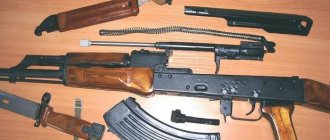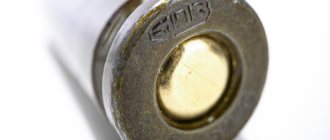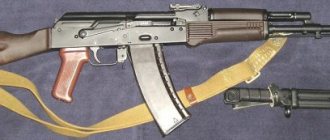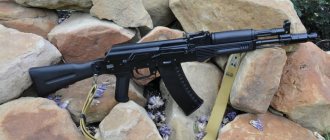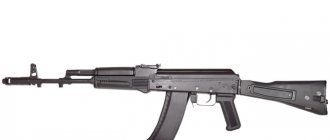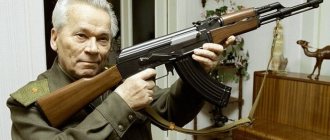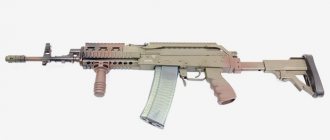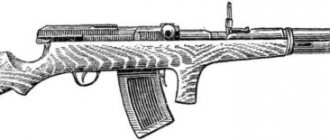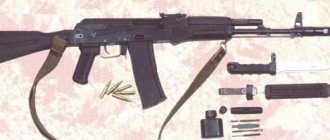As you know, as a result of the beginning and long duration of the so-called “cold” war between the USSR and the USA (think between the entire capitalist and socialist world), an extremely energy- and resource-intensive arms race was waged.
What's more powerful?
SA-006Kalashnikov
It was important not only to keep up, but also to overtake the enemy, to be better in everything, and not just in certain parameters. And what is natural is that during such intense work of scientific and creative thought, real, so to speak, “masterpieces” of military equipment were born, which could have a significant impact on the development of entire countries!
The Kalashnikov assault rifle, launched into production in 1947, was and is still considered just such a “masterpiece” and manifestation of the genius of the Soviet man. But few people know that he had a competitor, who ultimately had higher fighting qualities than the AK.
Correct deficiencies
The wild popularity of the AK in the world was explained by its high lethality, extreme ease of assembly and use, as well as its unpretentiousness to weather conditions - it could work perfectly in mud, rain, etc. It was these qualities that made the products of the Izhevsk plant so widespread around the world that it was called the “machine gun of the revolution,” because in many countries where there were civil wars and they tried to overthrow the current government by military means, it was the AK that was used.
But it also had serious shortcomings. Due to the design features, it was extremely difficult, even impossible, to conduct long targeted burst fire. In certain combat situations, this factor was not so important, but during pre-planned and calculated military operations, accuracy readings could be one of the decisive values.
Expert opinion
Ivan Fedorovich Schwartz
Analyst and one of the leaders of the branch of internal research of secret affairs at the Information Committee of the Council of Ministers of the USSR.
Therefore, in the 70s, it was decided to either modify the design of the AK, or create a new machine gun that would be superior to its already obsolete competitor.
World Of Man Dreams
The Konstantinov SA-006 assault rifle is interesting because it competed strongly with the Kalashnikov assault rifle in the competition of 1968-1973, when the Soviet army selected and adopted a new set of small arms chambered for a small-caliber, low-pulse 5.45 mm cartridge. Tells For the first time, the Konstantinov SA-006 assault rifle, developed in the design bureau of the Kovrov Mechanical Plant, was put up for testing in the fall of 1968, where it was opposed by the Kalashnikov A3 assault rifle from Izhevsk with a classical automation circuit, as well as the Korobov TKB-072-1 assault rifle from Tula with balanced automation . The Konstantinov assault rifle itself also had balanced automation, the concept of which was developed by engineer Pyotr Tkachev from TsNIITOCHMASH in the mid-sixties.
The next stage of testing the new machines was carried out at TsNIITOCHMASH in the fall of 1969. It involved a modified A-3 assault rifle designed by Kalashnikov, a TKB-072-1 assault rifle designed by Korobov and SA-006 designed by Konstantinov. As a result, only the A-3 assault rifle practically satisfied the requirements for reliability of automatic operation, survivability of parts, shooting safety and operational characteristics. Of the other machines, the best results for the specified parameters were obtained on the SA-006 machine. As a result, all three “main participants” - A-3, TKB-072-1 and SA-006 - were recommended for field testing after modifications.
During the tests, comments were caused by the excessive complexity of servicing the SA-006 assault rifle. According to the test report, it took 55 minutes to completely clean the A-3 assault rifle. Complete cleaning of the SA-006 assault rifle required 1 hour 35 minutes, with the main difficulties caused by cleaning the racks and gears of the return-balancing mechanism, as well as the insides of the receiver. Based on the results of field tests in 1971, only the Kalashnikov A3 assault rifle and the Konstantinov SA-006 assault rifle were selected for military testing, since the Korobov assault rifle showed unsatisfactory results in a number of parameters.
Military tests of the new assault rifles were scheduled for 1971. Tests were carried out in the Moscow and Transbaikal military districts. During testing, both machines showed the required reliability and survivability, as well as other operational and technical characteristics in accordance with TTT. In addition, the new set of weapons chambered for 5.6mm caliber, regardless of the type of machine gun, provided a significant increase in overall firing efficiency compared to the 7.62mm AKM. This was achieved by increasing the wearable ammunition (due to a 50% lighter cartridge), reducing the influence of errors in determining the range to the target due to the greater flatness of the bullet trajectory. In the conclusion of the tests, the following was written: “During single training firing exercises and combat firing within squads, the SA-006 and A-3 assault rifles showed almost equivalent fire efficiency results and were 1.3 times superior to the standard AKM assault rifle. According to the results of special shooting for fire efficiency, the superiority of the SA-006 and A-3 assault rifles over the AKM in general across all lines was 1.11 and 1.07 times.
In operational terms, the SA-006 assault rifle has a number of serious and fundamental shortcomings: • high force for cocking the moving parts (in some cases, it was impossible to cock the moving system with hand force on assault rifles contaminated by shooting); • a lot of smoke when firing (interferes with aiming during the day, and at night causes contamination of the luminous point on the front sight); • the possibility of incorrect assembly of the machine and other disadvantages
The A-3 assault rifle, while structurally representing an almost complete analogy with the standard AKM assault rifle, has no serious operational deficiencies. Considering the prospects of the new cartridge, the need to establish industrial production of cartridges, it is considered possible, before testing a more efficient and operationally advanced assault rifle, to recommend the adoption of a 5.6-mm cartridge in combination with the A-3 assault rifle, considering it a modification of the AKM assault rifle in a small caliber ."
Thus, in 1973, a decision was made to adopt the 5.45mm Kalashnikov AK-74 assault rifle. Kovrov engineers, in turn, continued the development of assault rifles with balanced automatics based on the SA-006, the development of which became the line of AEK-971 and Kord-5.45 assault rifles.
The Konstantinov SA-006 assault rifle uses balanced gas exhaust automation. The balancer has its own gas piston and is located above the muzzle of the barrel. The gas chamber is T-shaped, open at both ends, so that a piston connected to the bolt frame enters it from the rear, and a balancer piston enters from the front. The synchronization of the balancer and the main gas piston is carried out by two gears located one after the other. The gas piston rod and the balancer rod are made of stamped steel sheet and have a U- and U-shaped section, respectively, so that the synchronizing gears are located in the channel formed by these sections. There are two return springs, for the bolt group and the balancer, respectively. They are located parallel, side by side, above the bolt carrier and balancer rods. The barrel bore is locked using a rotating bolt. The entire moving group (bolt carrier with bolt and rod, balancer, synchronizing gears in the carriage and return springs on the guide rods) is removed from the weapon as a single block. If necessary, it can be completely disassembled for cleaning, lubrication and detailed inspection. The trigger mechanism is trigger-type, similar to an AKM assault rifle. The safety switch is located on the right side of the receiver, has three positions (off, single and burst), and is on the same axis with a dust curtain that covers the slot for the cocking handle when the safety is turned on. The stock, fore-end and pistol grip are made of laminated plywood. The stock has large recesses on the sides to reduce weight. A pencil case with accessories for cleaning and disassembling weapons is stored in a cavity in the lower part of the pistol grip. There is a single-chamber muzzle brake-compensator on the muzzle of the barrel. The sights are mechanical, the adjustable rear sight is mounted on a removable receiver cover.
| Characteristic | Meaning |
| Chuck used | 5.45×39 7Н6 7Н10 7Н22 |
| Automation type | automatic |
| USM type | sa |
| Length, mm | 925 |
| Barrel length, mm | 415 |
| Weight without cartridges, kg | 3,57 |
| Magazine capacity, cartridges | 30 |
| Rate of fire, rounds/min | 900-1000 |
Better than Kalashnikov
The SA-006 became exactly such a weapon, which, although it was similar to its predecessor in design, at the same time corrected many of its shortcomings. The caliber of the cartridge was reduced, and a shock absorber specially designed for this purpose was added, which reduced the recoil from shooting by almost half!
In parallel with the SA-006, the next generation of AKs, the AK-74, was also being developed. They also reduced the caliber of the cartridge and tried to reduce recoil, which, compared to the “ancestor,” they succeeded in doing. Both projects were considered generally successful and combat-ready. Now we had to find out at the training ground, in direct tests, which weapon turned out better.
And here the undoubted leader was SA-006. Even though its competitor showed very, very decent results, the SA’s shooting accuracy was 1.5 times higher, with similar power and a slightly higher rate of fire. But in the end it was the AK-74 that was accepted.
Konstantinov assault rifle SA-006 (USSR)
The Konstantinov SA-006 assault rifle is interesting because it competed strongly with the Kalashnikov assault rifle in the competition of 1968-1973, when the Soviet army selected and adopted a new set of small arms chambered for a small-caliber, low-pulse 5.45 mm cartridge. For the first time, the Konstantinov SA-006 assault rifle, developed in the design bureau of the Kovrov Mechanical Plant, was put up for testing in the fall of 1968, where it was opposed by the Kalashnikov A3 assault rifle from Izhevsk with a classical automation circuit, as well as the Korobov TKB-072-1 assault rifle from Tula with balanced automation. The Konstantinov assault rifle itself also had balanced automation, the concept of which was developed by engineer Pyotr Tkachev from TsNIITOCHMASH in the mid-sixties.
Konstantinov assault rifle SA-006
The next stage of testing the new machines was carried out at TsNIITOCHMASH in the fall of 1969. It involved a modified A-3 assault rifle designed by Kalashnikov, a TKB-072-1 assault rifle designed by Korobov and SA-006 designed by Konstantinov. As a result, only the A-3 assault rifle practically satisfied the requirements for reliability of automatic operation, survivability of parts, shooting safety and operational characteristics. Of the other machines, the best results for the specified parameters were obtained on the SA-006 machine. As a result, all three “main participants” - A-3, TKB-072-1 and SA-006 - were recommended for field testing after modifications.
During the tests, comments were caused by the excessive complexity of servicing the SA-006 assault rifle. According to the test report, it took 55 minutes to completely clean the A-3 assault rifle. Complete cleaning of the SA-006 assault rifle required 1 hour 35 minutes, with the main difficulties caused by cleaning the racks and gears of the return-balancing mechanism, as well as the insides of the receiver. Based on the results of field tests in 1971, only the Kalashnikov A3 assault rifle and the Konstantinov SA-006 assault rifle were selected for military testing, since the Korobov assault rifle showed unsatisfactory results in a number of parameters.
Military tests of the new assault rifles were scheduled for 1971. Tests were carried out in the Moscow and Transbaikal military districts. During testing, both machines showed the required reliability and survivability, as well as other operational and technical characteristics in accordance with TTT. In addition, the new set of weapons chambered for 5.6mm caliber, regardless of the type of machine gun, provided a significant increase in overall firing efficiency compared to the 7.62mm AKM. This was achieved by increasing the wearable ammunition (due to a 50% lighter cartridge), reducing the influence of errors in determining the range to the target due to the greater flatness of the bullet trajectory. In the conclusion of the tests, the following was written: “During single training firing exercises and combat firing within squads, the SA-006 and A-3 assault rifles showed almost equivalent fire efficiency results and were 1.3 times superior to the standard AKM assault rifle. According to the results of special shooting for fire efficiency, the superiority of the SA-006 and A-3 assault rifles over the AKM in general across all lines was 1.11 and 1.07 times.
In operational terms, the SA-006 assault rifle has a number of serious and fundamental shortcomings: • high force for cocking the moving parts (in some cases, it was impossible to cock the moving system with hand force on assault rifles contaminated by shooting); • a lot of smoke when firing (interferes with aiming during the day, and at night causes contamination of the luminous point on the front sight); • the possibility of incorrect assembly of the machine and other disadvantages
The A-3 assault rifle, while structurally representing an almost complete analogy with the standard AKM assault rifle, has no serious operational deficiencies. Considering the prospects of the new cartridge, the need to establish industrial production of cartridges, it is considered possible, before testing a more efficient and operationally advanced assault rifle, to recommend the adoption of a 5.6-mm cartridge in combination with the A-3 assault rifle, considering it a modification of the AKM assault rifle in a small caliber ."
Thus, in 1973, a decision was made to adopt the 5.45mm Kalashnikov AK-74 assault rifle. Kovrov engineers, in turn, continued the development of assault rifles with balanced automatics based on the SA-006, the development of which became the line of AEK-971 and Kord-5.45 assault rifles.
Konstantinov assault rifle SA-006
Konstantinov assault rifle SA-006, incomplete disassembly
The Konstantinov SA-006 assault rifle uses balanced gas exhaust automation. The balancer has its own gas piston and is located above the muzzle of the barrel. The gas chamber is T-shaped, open at both ends, so that a piston connected to the bolt frame enters it from the rear, and a balancer piston enters from the front. The synchronization of the balancer and the main gas piston is carried out by two gears located one after the other. The gas piston rod and the balancer rod are made of stamped steel sheet and have a U- and U-shaped section, respectively, so that the synchronizing gears are located in the channel formed by these sections. There are two return springs, for the bolt group and the balancer, respectively. They are located parallel, side by side, above the bolt carrier and balancer rods. The barrel bore is locked using a rotating bolt. The entire moving group (bolt carrier with bolt and rod, balancer, synchronizing gears in the carriage and return springs on the guide rods) is removed from the weapon as a single block. If necessary, it can be completely disassembled for cleaning, lubrication and detailed inspection. The trigger mechanism is trigger-type, similar to an AKM assault rifle. The safety switch is located on the right side of the receiver, has three positions (off, single and burst), and is on the same axis with a dust curtain that covers the slot for the cocking handle when the safety is turned on. The stock, fore-end and pistol grip are made of laminated plywood. The stock has large recesses on the sides to reduce weight. A pencil case with accessories for cleaning and disassembling weapons is stored in a cavity in the lower part of the pistol grip. There is a single-chamber muzzle brake-compensator on the muzzle of the barrel. The sights are mechanical, the adjustable rear sight is mounted on a removable receiver cover.
Konstantinov assault rifle SA-006, device diagram
| Characteristic | Meaning |
| Chuck used | 5.45×39 7Н6 7Н10 7Н22 |
| Automation type | automatic |
| USM type | sa |
| Length, mm | 925 |
| Barrel length, mm | 415 |
| Weight without cartridges, kg | 3,57 |
| Magazine capacity, cartridges | 30 |
| Rate of fire, rounds/min | 900-1000 |
According to the established scheme
Expert opinion
Mercury Stepan Igorevich
A prominent historian, expert in the field of research into the history of the USSR, member of the archaeological society, academician.
The reason for this decision is simple and even banal - it was easier and more convenient for many factories to produce parts and cartridges specifically for Kalashnikov assault rifles, since they had been doing this for decades.
And if SA-006 had been accepted for development, then a lot would have had to be modernized or simply changed, which would have cost a pretty penny. And since the AK-74 itself showed very decent results, we decided to stick with it.
